Hello everyone, my name is Weiran Wang. I am an international student currently study in University of Victoria. My major is economics, and I am a fourth year student. I am from Ningbo ,China, which is a beautiful city. Moreover, my interests are quite wide. I like baking at home, reading books, or listening to musics. I also like to go hiking and watch movies with friends. I joined this class is because I am interesting in learning new method,. After finish this course I hope that I can be able to apply the knowledge in daily life. I believe this course will be a very interesting course.
Author: weiranw (Page 2 of 2)

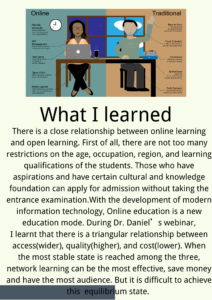
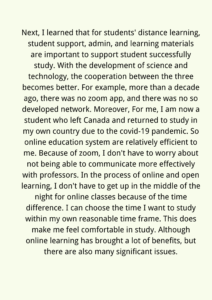

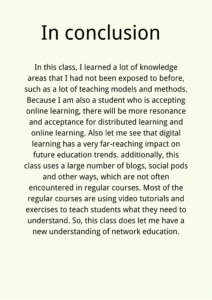
References:
Regan, P.,& Jesse, J. (2019). Ethical challenges of edtech, big data and personalized learning: Twenty-first century student sorting and tracking. Ethics and Information Technology, 21(3), 167-179.
Selwyn, N., Hillman, T., Eynon, R., Ferreira, G., Knox, J., Macgilchrist, F., & Sancho-Gil, J. M. (2019). What’s next for Ed-Tech? Critical hopes and concerns for the 2020s. Learning, Media and Technology, 1–6.
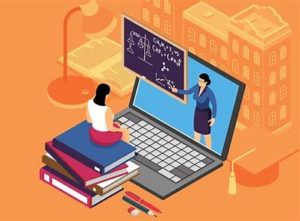
Through course study, I learned that UDL and online learning are directly different. Online education is an all-round communication between teachers and students, students and students through the Internet, which can shorten the psychological distance between teachers and students, and increase the opportunities and scope of communication between teachers and students. Online education is an education method that is compatible with traditional teaching methods such as face-to-face, correspondence and self-study, and a variety of media optimization combinations.
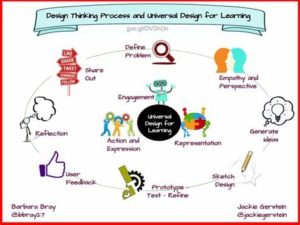
However, UDL is focus on students and learning instead of teachers, schools and teaching; adopt various teaching and learning methods; remove and break through various restrictions and obstacles to learning. Moreover, open education does not have too many restrictions on the age, occupation, region, and academic qualifications of the enrol-lees. Any aspiring learner with a certain cultural and knowledge base can apply for admission without taking an entrance examination.
Personally, I am now a student who left Canada and returned to study in my own country due to the covid-19 pandemic. So both online learning and UDL are relatively efficient to me. In contrast, UDL will make me feel more reasonable because I don’t have to get up in the middle of the night for online classes because of the time difference. I can choose the time I want to study within my own reasonable time frame. This has greatly improved my learning efficiency. Additionally, I am an international student, the language foundation is relatively weak, and the progress of learning will be slow, so UDL is very beneficial for me, I can control the progress of learning according to my learning ability. Finally, I think the combination of the UDL and online learning model will maximize my learning efficiency. For students, the combination of UDL and online teaching mode will give students more choices in their own learning, and also enable students to learn exactly what they want to learn.
What impressed me most is the 8 attributes of open pedagogy, which details examples based on open practices and theory, proposed by the author of the paper “Attributes of Open Pedagogy: A Model for Using Open Educational Resources”.
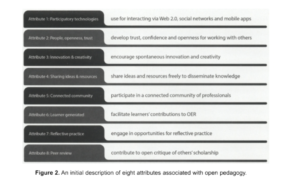
Hegarty, B. states ” It is impossible to discuss participatory technologies without mentioning innovation, trust, sharing, collaboration, connectedness, peer interaction and review, learner contributions, or reflective practice”(P, 10). A single model cannot be carried out smoothly, but requires the cooperation and cooperation of multiple parties to be effective. I am very grateful that this lesson allowed me to learn a lot of new knowledge about online teaching. In the third group assignment, I also learned how to effectively communicate with group members through the Internet.
Reference
Hegarty, B. (2015). Attributes of Open Pedagogy: A Model for Using Open Educational Resources. Educational Technology, 55(4), 3-13.

The development process of educational technology
Firstly, the development process of educational technology can be roughly divided into the following stages:
1. The budding stage—-the end of the 19th century
2. The initial stage—-the early 20th century to the 1920s
3. Stage of rapid development—-1930s to 1960s
4. Systematic development stage—-1960s to 1980s
5. Network development stage—–modern education technology (1990s to present)
In this long development process, there are many different kinds of educational tools have been used. The earliest educational technology can be traced back to the clay calligraphy and painting invented by the Sumerians in 3000 BC. The earliest education is through oral communication and writing. After the rapid development of modern science and technology, projectors and other intelligent electronic equipment appeared. Recent years, online learning has become the most popular existence in educational technology. We no longer learn from face to face, but use audio or video to establish communication and learning.
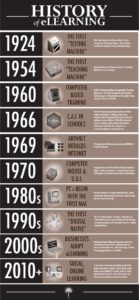
The earliest educational equipment appeared in 1924, and nowadays we can build open learning classrooms and use all the equipment that we needed for classrooms through the Internet. Open learning on the Internet provides a high degree of mobility and freedom for students, and students can also choose the way they like to learn. For example, in the process of learning professional knowledge, you can also gain skills and knowledge in different fields. However, even today when Internet information is super developed, the education platform built on the Internet is still very weak because there is no perfect solution to the coverage of network signal and the synchronization of teaching information. The following words appeared in the ppt of Sir John Daniel, O.C.:
- ACCESS (wider)
- QUALITY (higher)
- COST (lower)
He believes that there is a triangular relationship between the three of them. When the most stable state is reached among the three, network learning can be the most effective, save money and have the most audience. But it is difficult to achieve this equilibrium state.
Rreference:
Sutori. (n.d.). Retrieved October 25, 2020, from https://www.sutori.com/story/educational-technology-timeline–mNL3LPQAPeDbEQ7DNkpjdNGV
My Experience Of Online Learning
This should be the first time I use Discord to participate in a course, the topic of online and open learning is actually quite strange to me. In this class, all classmates and my group members can discuss the content of the course and the problems encountered online. The problem of people in different time zone and whether the course communication is effective is that our group talks most. We also use many social softwares like email or zoom to communicate with each other. I was quite nervous and at a loss for this course, but with the communication and help of our team members, I feel a bit more confident.
Aware of digital security issues and online privacy
In today’s world, almost everyone can connect, whether it’s checking emails, updating on social networks, or buying online. The fact is that we are connected to the Internet most of our lives. With the development of technology and the emergence of big data, it does bring a lot of convenience to our lives, but it also exposes our privacy to the Internet. I found some interesting quote during my reading.
- “Not only is there more information collected from more sources but much of the data collection takes place without the individual’s aware-ness.”(Regan et al. P 170)
- Educational data are often stored in large, longitudinal data sets from which personally identifiable variables have been removed. These data sets are used for reporting pur-poses from the school to district to state departments of education and finally to the federal government.(Regan et al. p 171)
- Although edtech personalized learning systems may eliminate human bias from educators in the school, it does introduce possible bias of those who design the systems and machine bias as the systems learn and evolve.(Regan et al. p 176)
Therefore, how to protect out privacy and security in open online learning, and how to choose a good online learning and communication tool is very important. When we learn through the learning platform, we must be careful to use personalized learning services, search services, and location services.
Reference
Regan, Priscilla M., and Jolene Jesse. “Ethical Challenges of Edtech, Big Data and Personalized Learning: Twenty-First Century Student Sorting and Tracking.” Ethics and Information Technology, vol. 21, no. 3, 2018, pp. 167–179.
Smith, Megan, et al. “Going the Distance: Online Learning Ideas.” Creative Language Class, 13 Mar. 2020, www.creativelanguageclass.com/online-learning-ideas/.
